October 2003
practical wisdom
4 October 2003, around 17.46.
Dickinson is not known to have met with the new and exciting novels by American women that dominated the market in the 1850s, many of them patterned after The Wide, Wide World by Susan Warner: perhaps they were secured out by Amherst’s tastemakers. Whatever the explanation, most of the women’s books that crossed Dickinson’s path at this time came from England and were pitched to the religious trade.
Dare I suggest that the prevalence of English authors in the books read by Emily Dickinson was due to the lack of a copyright agreement between England and the USA in the nineteenth century, which would make (‘pirated’) works by English authors substantially less expensive for an American reader than the works of the reader’s compatriots? Just a thought.
(cf. Emerson’s English Traits: ‘Every book we read, every biography, play, romance, in whatever form, is still English history and manners. So that a sensible Englishman once said to me, ‘As long as you do not grant us copyright, we shall have the teaching of you’.’)
stroll
11 October 2003, around 17.45.
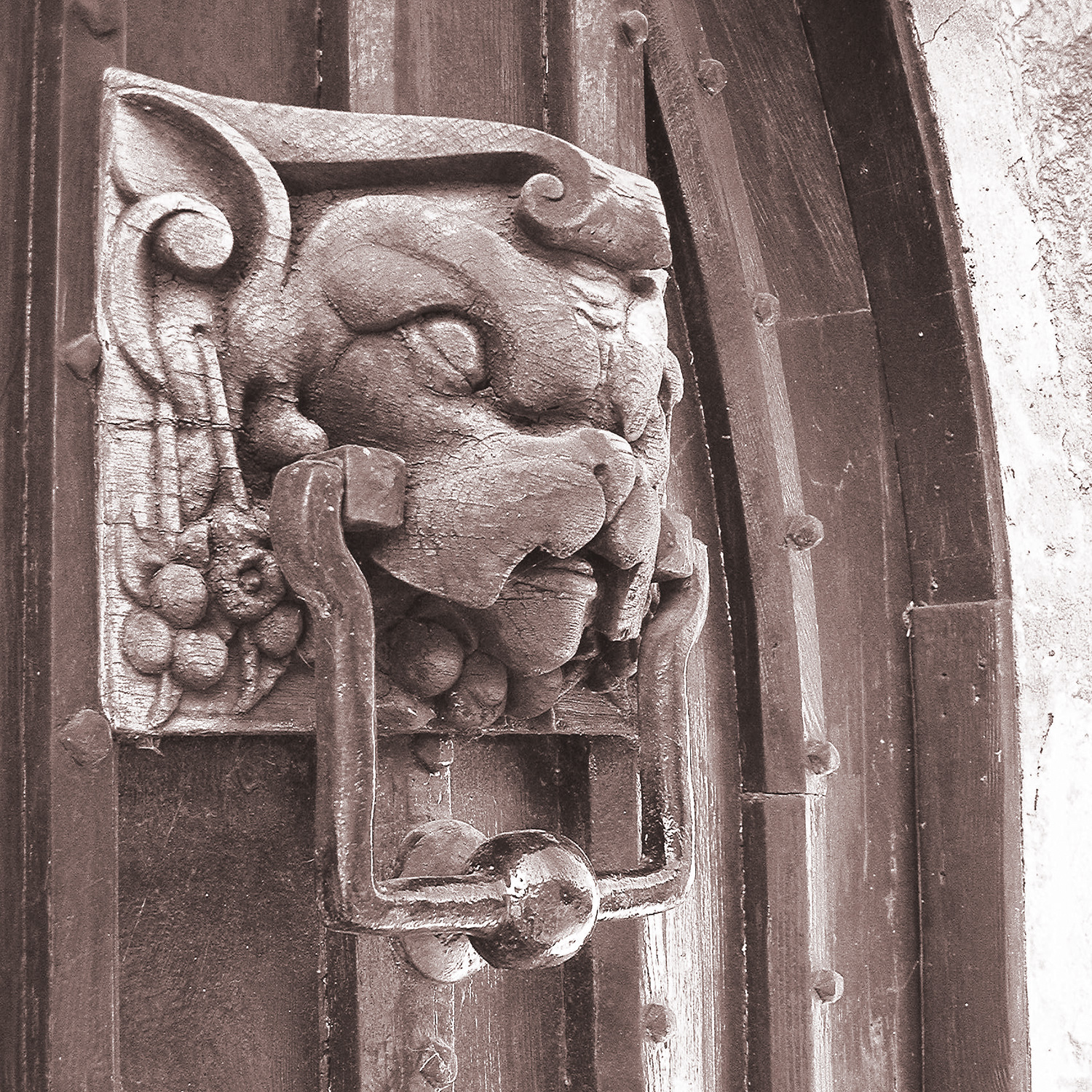
Church Way, Iffley.
twigs
15 October 2003, around 18.25.

Prisoners in Bangladesh pleading for their lives
in a news photograph from the
London Daily Express, 20.xii.1971.
on my desk
17 October 2003, around 10.45.
- Book marks
- Books
- Alternatives to Athens
- Henry Auden’s Greek Prose Phrase Book (ca. 1949 — ‘It is similar to Meissner, but with the difference that it is not so elaborate and does not profess to contain everything, its object being rather to stimulate a boy’s own activity and suggest that he should add more phrases from his own reading,—it is for this purpose that the book has been interleaved. Boys ought to do something for themselves towards scholarship. They nowadays expect to have everything done for them.’)
- Cicero: Cato Maior, Laelius
- Dictionaries (Little Liddell, Autenrieth’s Homeric Dictionary, Lewis & Short)
- Economic and Social History of the Ottoman Empire (2 vols.)
- Fowler’s Modern English Usage
- Gildersleeve & Lodge Latin Grammar
- Laptop (which hiccoughs)
- Bradner & Lynch, eds. The Latin Epigrams of Thomas More
- Leges Graecorum Sacrae
- Lucian, OCT vol. 1
- Myth, Ritual, Memory, and Exchange: Essays in Greek Literature and Culture
- Pestman’s New Papyrological Primer
- Slavery and the Roman Literary Imagination
- B. H. Warmington, Carthage
- Coffee-stained mug, with dregs
- Three notebooks, red
- Pamphlets, various (i.e. reprints and extracts from journals, Festschriften, etc.)
- Paper (letterhead, note-paper, etc.)
- Photocopies (from SIG, SEG, Arethusa, & Revue Archéologique)
- Photos, various
- Printer, with blue paper
- Survey (incomplete) of working conditions
- Writing implements, various
A view (10)
19 October 2003, around 11.54.
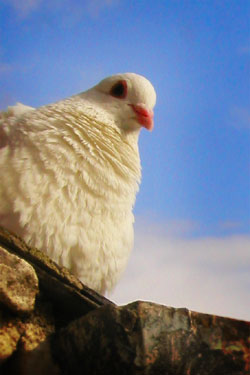
Afternoon of the inquisitive pigeon.
the emphasis was helped
21 October 2003, around 7.48.
Menas: These three world-sharers, these competitors,
Are in thy vessel: let me cut the cable;
And, when we are put off, fall to their throats:
All there is thine.
Pompey: Ah, this thou shouldst have done,
And not have spoke on’t! In me ’tis villany;
In thee’t had been good service. Thou must know,
’Tis not my profit that does lead mine honour;
Mine honour, it. Repent that e’er thy tongue
Hath so betray’d thine act: being done unknown,
I should have found it afterwards well done;
But must condemn it now. Desist, and drink.
Of all of Shakespeare’s plays, Antony and Cleopatra appealed to me the least, with Romeo and Juliet coming in a close second; that, however, is not my theme. Rather, I would like to observe that until I read the play after reading more about the second triumvirate,1 I never understood why modern scholars emphasized the failure of Sextus Pompeius to take advantage of this meeting on his galley—nor why this tidbit of information was offered with a smirk and a flourish.2 Leaving out the usual self-deprecation at this junction, I will merely note that though poetry cannot necessarily alter the course of history, it can at least change the emphasis.3
- ‘Oh, look,’ said the lecturer, ‘it’s the gang-of-three.’ [↩]
- Yes, thank you, I did get the sly use of Shakespeare’s description of Cleopatra’s barge (2.2 — stolen, I must add, from Plutarch) in Stoppard’s Arcadia—I’m not a complete idiot, you know. [↩]
- One could write many and learned things about the reading-plans of historians and their impact on our understanding or perception of history, but I would rather not do so just yet. [↩]
nb
23 October 2003, around 8.55.
Talk of religion, it is odds you have infidel, blasphemer, atheist, or schismatic, thundered in your ears; touch upon your politics, you will be in luck if you are only charged with a tendency to treason.
Crambe repetita (1)
25 October 2003, around 8.47.
… ὁ δ’ ἐξολισθὼν ἱκέτευε τὴν κράμβην
τὴν ἑπτάφυλλον, ἣν θύεσκε Πανδώρηι
Ταργηλίοισιν ἔγκυθρον πρὸ φαρμακοῦ …
…once he’d slipped away, he implored the cabbage—seven-leaved!—which he always offered—potted!—to Pandora at the Thargelion for a pharmakos1 …
- I am not best pleased—with either Hipponax’s fragment or my Englishing thereof; mind you, I have nothing against beseeching (hiketeuein) a cabbage, but I would like a context (besides the Thargelion). I want to know what this character is slipping away (or down) from, and why the cabbage (or something else) is in a ceramic dish (or potted). Also, if it is the cabbage that’s in the dish, why on earth would one offer a potted cabbage to Pandora? I’d think she’d have her own problems, without having to worry about some silly cabbage; also, I don’t suppose it’s really a substitute: potted cabbage for scapegoat—it wouldn’t be very satisfying to beat it with fig branches, would it? ( Admittedly, the phrase could be temporal—i.e. before the scourging of the pharmakos, but the cabbage as replacement pharmakos seems more amusing.) [↩]
Socrates Silenos
27 October 2003, around 8.49.
Began reading The Mask of Socrates: the Image of the Intellectual in Antiquity, and was struck by the following passage:
The earliest portrait of the philosopher originated about ten to twenty years after his death and shows him in the guise of Silenus. In flouting the High Classical standard of beauty so blatantly, this face must have disturbed Socrates’ contemporaries no less than his penetrating questions (32).
Please note the similarities:
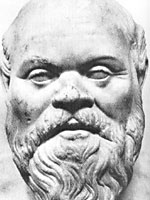 |  |
| Socrates (Roman copy of Greek original, ca. 380BC) | Silenus (Italian antefix, ca. 470–460BC)1 |
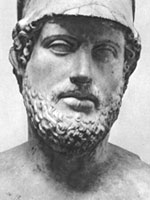
Pericles
(ca. 440BC)
Why would a pug-nosed Socrates be ‘disturbing’? Taken on his own terms, I suppose he wouldn’t be, but of course the portrait, like the individual it represented, could not be taken on its own terms—so take a moment and compare the portrait of Socrates with the slightly earlier portrait of the statesman Pericles. Note the regularity of Pericles’ features, the trimness of the beard, the overshadowing helmet signifying the concern he bore to protect Athens; note, too, the impassive gaze, the lack of wrinkles. The portrait is idealized on so many different levels it would be difficult to enumerate them. Return to Socrates. The nose, which next to that of the Silenos had seemed almost moderate, now verges on the grotesque; the laugh wrinkles at the eyes (which may, admittedly, be a Roman addition) complement the full, jovial cheeks somewhat lacking in Periclean seriousness; the bald head and rather unkempt beard suggest a man unconcerned with keeping up appearances—which in an age of appearances (when virtue is a matter of kalokagathia) is almost unpatriotic.
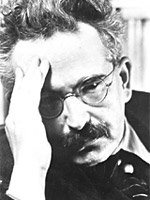
Walter Benjamin
Whether a perfect profile is a civic virtue and a pug nose the mark of barbarism is for those more learned in aesthetics to decide. Whether the artist who sculpted the portrait of Socrates meant to make a ‘statement’ supporting Socratic measures of goodness (as Zanker hints) is open to dispute. That one’s idea of an ‘intellectual’—and what one expects from such a person—can and has been shaped by images is not to be doubted. ‘viewers find in this face what they look for, based on their personal preconceptions of the subject, especially … where the different renderings of the expression in the various preserved copies seem at different times to favor one or another interpretation’ (40). Zanker describes the photograph at right as ‘Walter Benjamin looking out at the viewer, his head propped on his hand, his face filled with loneliness and weltschmerz’ (333).2 Is this what people today expect of the ‘intellectual’, loneliness and weltschmerz—is this mere ivory-tower romanticism? Other images may be useful (e.g. Derrida, Said).3
- The original link
http://www.clevelandart.org/exhibcef/mg/html/8906609.htmlhas rotted, but the piece is in the Museo Archeologico Regionale di Gela, inv. 8294, cat. no. 63. There’s an article about the Cleveland exhibition in Minerva Magazine [PDF!] from 2002. Cf. a rather more human antefix in the Walters Collection. [↩] - I would like to know how this iconography differs significantly from the Hellenistic ‘rigors of thinking’ on which Zanker spends an entire chapter (pp.90–145), but not just yet. (I grant you the glasses, but still, the crazy hair, the funny clothes, the hand to brow… there’s got to be more to a modern intellectual than myopia). [↩]
- Zanker’s other well-known book, The Power of Images in the Age of Augustus (again translated by Alan Shapiro and based on a series of lectures Zanker gave) is also amusing and deals with the overt manipulation of images for political purposes. How far one can agree with Zanker is a matter of opinion, but his books (and articles) are quite enjoyable to read. [↩]
a well lerned gentylwoman
29 October 2003, around 11.09.
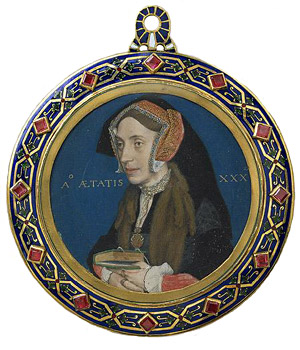
Margaret More Roper
(Holbein, ca. 1535, Met.)
Erasmus wrote many epistels to her, and dedicated his commentaries on certaine hymnes of Prudentius to this gentlewomen, and calleth her the flower of all learned matrones of England. Nor was she meanlie learned. She compounded in Greeke and latyn both verse and prose, and that most eloquentlie. Her witt was sharpe and quicke, and to giue you a tast thereof, knowe this: Sainct Ciprians workes had bene in those dayes oftentymes printed, yet there remained amongst other faults one notable vncorrected, and thereof no perfect sence [c]ould be made, to the laming and blemishing of a most notable sentence and testimonie of so ancient and sacred a writer. The wordes were these: Absit enim ab Ecclesia Romana virgorem suum tam prophana facilitate dimittere, et nisi vos seueritatis, euersa fidei maiestate dissoluere. Which place when mistris Margaret red, presentlie, without any helpe of other example or instruction, ‘These wordes nisi vos must be,’ saith shee, ‘neruos.’ So the sentence, by mending of that worde nisi vos into neruos, is made plaine and perspicuous. This correction of hers is noted by Iohn Costerus in his commentaries vpon Vincentius Lirinensis, and Pamelius in his annotations on Sainct Ciprian epistle 31. … Yet for all this, shee was of that modestie and rare humilitie that shee misliked to heare her selfe praysed for any qualitie. She thought so lowlie of her owne witt and learninge that she was ashamed to haue any man to see her workes. This minde of hers greatlie pleased her Father [Sir Thomas More].
Margaret also translated Erasmus’ treatise on the pater noster into English; her daughter, Mary was, according to the Lyfe of Syr Thomas More, a translator as well:
This gentlewoman verie handsomlie translated the Eccliesiasticall historie of Eusebius out of Greeke into Latyn, and after into English yet extant, to the shame of the hereticall [translation] of Meridith Hanmer … She translated the Historie of Socrates, Theodoretus, Sozomenus and Euagrius. Theis of her modestie [she] caused to be suppressed. She also translated a treatiese of her grandfather, Sir Thomas, made vpon passion; and so elegantlie and so eloquentlie hath penned it that a man would thinke it were originallie written in the English tongue by Sir Thomas hym selfe (149f.)
